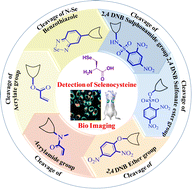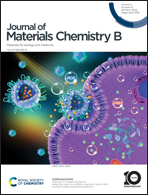Recent progress in the development of small-molecule fluorescent probes for detection and imaging of selenocysteine and application in thyroid disease diagnosis
Abstract
Selenocysteine (SeCys) is the 21st genetically encoded amino acid present in proteins and is involved in various biological functions. Inappropriate levels of SeCys can be considered as a sign of various diseases. Therefore, small molecular fluorescent probes for the detection and imaging of SeCys in vivo in biological systems are considered to be of significant interest for understanding the physiological role of SeCys. Thus, this article mainly provides a critical evaluation of recent advances made in SeCys detection along with the biomedical applications based on small molecular fluorescent probes published in the literature during the past half a dozen years. Therefore, the article primarily deals with the rational design of fluorescent probes, wherein these were selective towards SeCys over other biologically abundant molecules, in particular the thiol-based ones. The detection has been monitored by different spectral techniques, such as fluorescence and absorption spectroscopy and in some cases even visual color changes. Further, the detection mechanism and the utility of fluorescent probes for in vitro and in vivo cell imaging applications are addressed. For clarity, the main features have been conveniently divided into four categories based on the chemical reactions of the probe, viz., in terms of the cleavage of the responsive group by the SeCys nucleophile: (i) 2,4-dinitrobene sulphonamide group, (ii) 2,4-dinitrobenesulfonate ester group, (iii) 2,4-dinitrobenzeneoxy group and (iv) miscellaneous types. Overall this article deals with the analysis of more than two dozen fluorescent probes demonstrated for selective detection of SeCys along with their applications towards disease diagnosis.

- This article is part of the themed collections: Journal of Materials Chemistry B Recent Review Articles and #MyFirstJMCB


 Please wait while we load your content...
Please wait while we load your content...